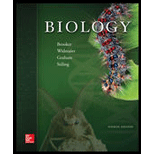
Introduction: Protists are known as the Earth’s first eukaryotes. These eukaryotes are not classified in the plant, animal, or fungal kingdom. Protists are abundant in moist habitats and are microscopic in size. They are informally labeled according to their ecological roles, habitats, and the type of motility.
Answer to Problem 1TY
Correct answer: If an individual is studying the evolution of animal-specific cell-to-cell signaling systems, then the representative species to choose for the observation will be Choanomonada. Hence, the correct answer is option c.
Explanation of Solution
Reason for correct answer:
The Choanomonada belongs to a group of choanoflagellates, which represent the closest living relatives of animals. The evolutionary biologists interested in the origin of animals choose Choanomonada as representative species. These organisms are believed to be the species that have closest association with the multicellular organisms (especially animals). Hence, the representative species to study the animal-specific cell-to-cell signaling system is Choanomonada.
Option c. is given as “Choanomonada”.
Choanomonada are unicellular eukaryotes whose genome is very similar to those of animals. Hence, the correct answer is option (c).
Reasons for incorrect answer:
Option a. is given as, “Rhodophyta”.
Rhodophyta is also known as red algae and they are able to perform photosynthesis. Photosynthesis is a process observed in plants and not in animals. This indicates that Rhodophyta represents a close association with plants. They cannot be used to study the animal-specific cell-to-cell signaling system. Hence, option a. is incorrect.
Option b. is given as, “Discoba”.
Discoba are unicellular eukaryotes with no specific classification. Hence, option b. is incorrect.
Option d. is given as, “Radiolaria”.
Radiolarian lives in an aquatic habitat and they are heterotrophic in nature. They cannot be used to study the evolution of cell-to-cell signaling system as they do not share similarities with the animal cells. Hence, option d. is incorrect.
Option e. is given as, “Chlorophyta”.
Chlorophyta is also referred to as green algae. They contain the same photosynthetic pigments that are present in the plants. Chlorophyta performs photosynthesis and shows a close association with plants and not animals. They cannot be used to study the animal-specific cell-to-cell signaling system. Hence, option e. is incorrect.
Hence, the options a., b., d., and e. are incorrect.
Choanomonada and animals share several genes, and it represents the closest living relative of animals. Hence, it is used as representative species for the animal-specific cell-to-cell signaling studies.
Want to see more full solutions like this?
Chapter 28 Solutions
Biology
- Outline the negative feedback loop that allows us to maintain a healthy water concentration in our blood. You may use diagram if you wisharrow_forwardGive examples of fat soluble and non-fat soluble hormonesarrow_forwardJust click view full document and register so you can see the whole document. how do i access this. following from the previous question; https://www.bartleby.com/questions-and-answers/hi-hi-with-this-unit-assessment-psy4406-tp4-report-assessment-material-case-stydu-ms-alecia-moore.-o/5e09906a-5101-4297-a8f7-49449b0bb5a7. on Google this image comes up and i have signed/ payed for the service and unable to access the full document. are you able to copy and past to this response. please see the screenshot from google page. unfortunality its not allowing me attch the image can you please show me the mathmetic calculation/ workout for the reult sectionarrow_forward
- Skryf n kortkuns van die Egyptians pyramids vertel ñ story. Maximum 500 woordearrow_forward1.)What cross will result in half homozygous dominant offspring and half heterozygous offspring? 2.) What cross will result in all heterozygous offspring?arrow_forward1.Steroids like testosterone and estrogen are nonpolar and large (~18 carbons). Steroids diffuse through membranes without transporters. Compare and contrast the remaining substances and circle the three substances that can diffuse through a membrane the fastest, without a transporter. Put a square around the other substance that can also diffuse through a membrane (1000x slower but also without a transporter). Molecule Steroid H+ CO₂ Glucose (C6H12O6) H₂O Na+ N₂ Size (Small/Big) Big Nonpolar/Polar/ Nonpolar lonizedarrow_forward
- what are the answer from the bookarrow_forwardwhat is lung cancer why plants removes liquid water intead water vapoursarrow_forward*Example 2: Tracing the path of an autosomal dominant trait Trait: Neurofibromatosis Forms of the trait: The dominant form is neurofibromatosis, caused by the production of an abnormal form of the protein neurofibromin. Affected individuals show spots of abnormal skin pigmentation and non-cancerous tumors that can interfere with the nervous system and cause blindness. Some tumors can convert to a cancerous form. i The recessive form is a normal protein - in other words, no neurofibromatosis.moovi A typical pedigree for a family that carries neurofibromatosis is shown below. Note that carriers are not indicated with half-colored shapes in this chart. Use the letter "N" to indicate the dominant neurofibromatosis allele, and the letter "n" for the normal allele. Nn nn nn 2 nn Nn A 3 N-arrow_forward
 Human Anatomy & Physiology (11th Edition)BiologyISBN:9780134580999Author:Elaine N. Marieb, Katja N. HoehnPublisher:PEARSON
Human Anatomy & Physiology (11th Edition)BiologyISBN:9780134580999Author:Elaine N. Marieb, Katja N. HoehnPublisher:PEARSON Biology 2eBiologyISBN:9781947172517Author:Matthew Douglas, Jung Choi, Mary Ann ClarkPublisher:OpenStax
Biology 2eBiologyISBN:9781947172517Author:Matthew Douglas, Jung Choi, Mary Ann ClarkPublisher:OpenStax Anatomy & PhysiologyBiologyISBN:9781259398629Author:McKinley, Michael P., O'loughlin, Valerie Dean, Bidle, Theresa StouterPublisher:Mcgraw Hill Education,
Anatomy & PhysiologyBiologyISBN:9781259398629Author:McKinley, Michael P., O'loughlin, Valerie Dean, Bidle, Theresa StouterPublisher:Mcgraw Hill Education, Molecular Biology of the Cell (Sixth Edition)BiologyISBN:9780815344322Author:Bruce Alberts, Alexander D. Johnson, Julian Lewis, David Morgan, Martin Raff, Keith Roberts, Peter WalterPublisher:W. W. Norton & Company
Molecular Biology of the Cell (Sixth Edition)BiologyISBN:9780815344322Author:Bruce Alberts, Alexander D. Johnson, Julian Lewis, David Morgan, Martin Raff, Keith Roberts, Peter WalterPublisher:W. W. Norton & Company Laboratory Manual For Human Anatomy & PhysiologyBiologyISBN:9781260159363Author:Martin, Terry R., Prentice-craver, CynthiaPublisher:McGraw-Hill Publishing Co.
Laboratory Manual For Human Anatomy & PhysiologyBiologyISBN:9781260159363Author:Martin, Terry R., Prentice-craver, CynthiaPublisher:McGraw-Hill Publishing Co. Inquiry Into Life (16th Edition)BiologyISBN:9781260231700Author:Sylvia S. Mader, Michael WindelspechtPublisher:McGraw Hill Education
Inquiry Into Life (16th Edition)BiologyISBN:9781260231700Author:Sylvia S. Mader, Michael WindelspechtPublisher:McGraw Hill Education





